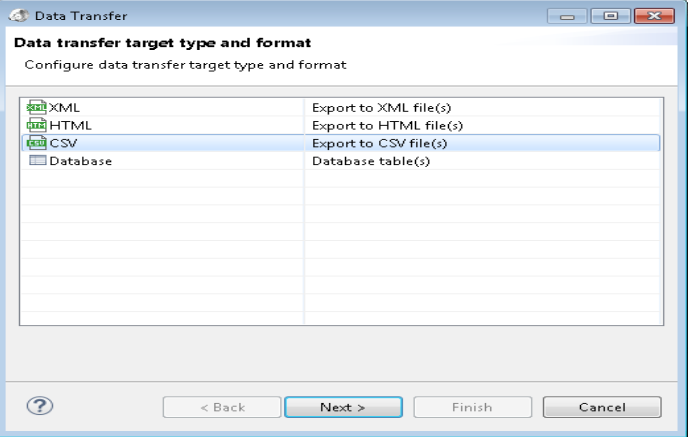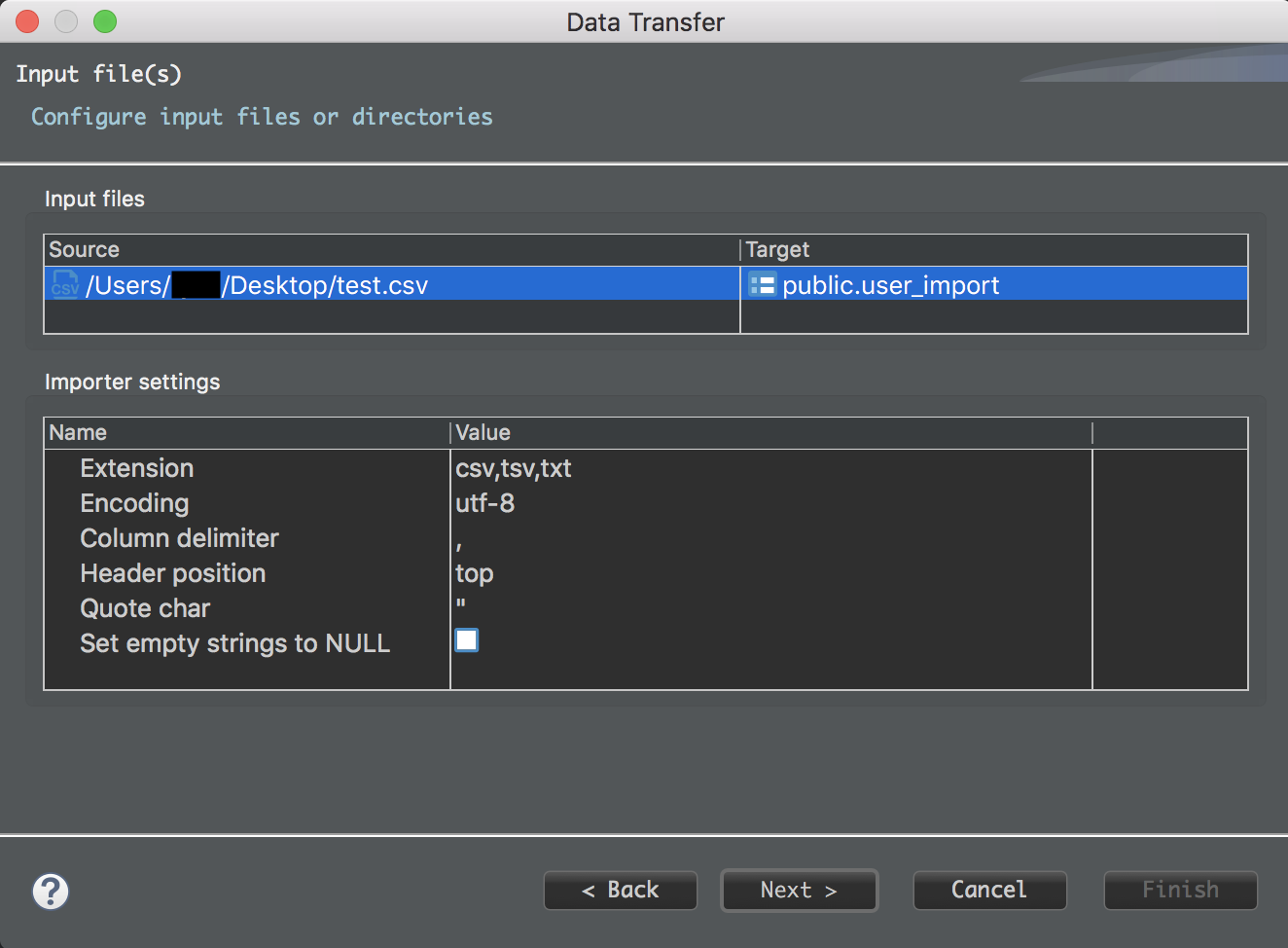
- DBEAVER EXPORT TO CSV HOW TO
- DBEAVER EXPORT TO CSV CODE
DBEAVER EXPORT TO CSV HOW TO
In this instructional article your knowledge grew about how to export data using Cockroach, CSV, and Python. Return render_template ( "errors.html", txtMessage = txtMessage )
DBEAVER EXPORT TO CSV CODE
TxtMessage = "Error: " + e + "/n SQL code we ran: " + s + "/n txtPathAndFile: " + txtPathAndFile

copy_expert (SQLforFileOutput, f_output )

WITH Open (txtPathAndFile, 'w' ) as f_output:ĬursorCRDB. # Set up a variable to store our file path and name. SQLforFileOutput = "COPY () TO STDOUT WITH CSV HEADER". connect (database =txtDBname, user =txtNameUser, sslmode =txtSSLmode, sslrootcert =txtSSLrootCert, sslkey =t_sslkey, sslcert =t_sslcert, host =txtHostURL, port =txtPortNum ) T_sslcert = 'certifs/'ĬonnCRDB = psycopg2. # create a SQL code to specify which values we want from the database. It requires the installation and import of the “psycop2g” library. This Psycopg2 function can be used to create a file (w), open for write (w), or open a file for reading (r).
And many others, including: FORMAT, OIDS, DELIMITER, NULL, HEADER, QUOTE, ESCAPE, FORCE_QUOTE, FORCE_NOT_NULL, and ENCODING. “parameters”: This optional field can have any of the following:. “STDOUT”: You can specify the data pulled from Cockroach to be sent as output for Python to gather up. “txtPathAndFile”: A path and file name can go here, which would tell CockroachDB where to save the file. “txtSQL”: You can plug some SQL into this spot instead of column names. If no columns are specified, all columns will be copied.  “col01”: Optional column names to be read. “tblData”: This refers to the Cockroach source table you want to pull data from. CockroachDB COPY TOĬOPY tblData (optional col01, col02, etc ) | optional txtSQL TO optional filePathAndFile | optional STDOUT WITH parameters After grasping how each function works, we will then build a chunk of scripts using that function to create a portion of our import application. For example, naming “txtVariableName” with the “txt” you see at the starting point in order to delineate it as a “text” or “string” type and “tbl” before table names in order to mark those objects as tables.īefore writing our Cockroach/Python application for importing files into CockroachDB, we will learn how to use the functions mentioned above. as you see us doing in this tutorial document. Optional and probably useful: why prefix variables, column names, table names, etc. It is not necessary for you to use the same tools we do. Here, we have used Visual Studio Code to write Python.
“col01”: Optional column names to be read. “tblData”: This refers to the Cockroach source table you want to pull data from. CockroachDB COPY TOĬOPY tblData (optional col01, col02, etc ) | optional txtSQL TO optional filePathAndFile | optional STDOUT WITH parameters After grasping how each function works, we will then build a chunk of scripts using that function to create a portion of our import application. For example, naming “txtVariableName” with the “txt” you see at the starting point in order to delineate it as a “text” or “string” type and “tbl” before table names in order to mark those objects as tables.īefore writing our Cockroach/Python application for importing files into CockroachDB, we will learn how to use the functions mentioned above. as you see us doing in this tutorial document. Optional and probably useful: why prefix variables, column names, table names, etc. It is not necessary for you to use the same tools we do. Here, we have used Visual Studio Code to write Python.  Ability to write applications with languages like Python, PHP, C#, Java, ASP.Net, VB.Net, and Node.js to write to a CockroachDB database. Cockroach doesn’t have many others available as of this writing. You will want to have a basic understanding of Cockroach, whether you’re utilizing the “dBeaver” tool (free) or another database admin tool. After learning how the primary pieces (functions) here work, we will code a Python application that uses all of these Cockroach and Python functions to extract data from a database into a CSV file. We will learn about the following functions to use for exporting a text file and copying that data into a CockroachDB table: Open(), Copy_Expert(), “Copy To”, render_template, and Format(). In this tutorial document we learn about how to export data from CockroachDB into a CSV using Python’s psycopg2 “OPEN” and “COPY_EXPERT” functions for creating a comma-delineated text file and moving data into that file, along with CockroachDB’s “COPY TO” function to get the data we want out of a Cockroach SQL code.
Ability to write applications with languages like Python, PHP, C#, Java, ASP.Net, VB.Net, and Node.js to write to a CockroachDB database. Cockroach doesn’t have many others available as of this writing. You will want to have a basic understanding of Cockroach, whether you’re utilizing the “dBeaver” tool (free) or another database admin tool. After learning how the primary pieces (functions) here work, we will code a Python application that uses all of these Cockroach and Python functions to extract data from a database into a CSV file. We will learn about the following functions to use for exporting a text file and copying that data into a CockroachDB table: Open(), Copy_Expert(), “Copy To”, render_template, and Format(). In this tutorial document we learn about how to export data from CockroachDB into a CSV using Python’s psycopg2 “OPEN” and “COPY_EXPERT” functions for creating a comma-delineated text file and moving data into that file, along with CockroachDB’s “COPY TO” function to get the data we want out of a Cockroach SQL code.








 0 kommentar(er)
0 kommentar(er)
